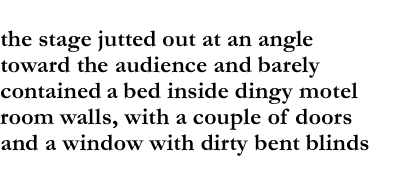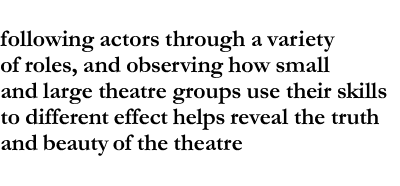Analyzing a theatre production is like gazing into a kaleidoscope and not only seeing the beautiful puzzle, but also trying to trace how each chip of glass fell into place to form it. There’s the play itself—the script, the characters, the story—and then there’s the production, in which the script is buffeted and shaped by the director’s vision for the play, the motivation and talents of the individual actors, and the choices of lighting, sound, and set design. A live performance carries a tension created by the chance of error and a sense of excitement at the possibility of witnessing an actor’s finest moment on stage. When a production works without a hitch, it’s easy to forget the rigorous rehearsals that must have preceded it, the individual artists and craftspeople that labored to make the show the best it could possibly be, the numerous pieces that coalesced magically at the very moment they had to.
As the theatre season began winding down and spring struggled in, I saw two fine productions by small theatre groups. The Boston University School of Theatre Arts presented a clean, true rendition of Cat on a Hot Tin Roof, and Industrial Theatre staged an edgy and emotionally charged Fool for Love. The former is a Southern tale of a troubled family, a love relationship that couldn’t be, and the resulting frustration and misery. The latter is a Western tale of a troubled family, a love relationship that couldn’t be, and the resulting frustration and misery. In both cases there is a dominant father figure, and in both plays the male protagonist drowns his yearning with a constant flow of liquor.

We already know the story of Brick and Maggie and Big Daddy and his illness and the rivals for his fortune. Cat on a Hot Tin Roof succeeds in no small part because of Tennessee Williams’ classic script with its old-fashioned emphasis on dialogue—intense, incessant, full of bitter wit. Playwright David Mamet says that the best plays could be put on the radio and lose nothing, and this is surely one of those plays. The BU production honored this by inserting no superfluous set details or flourishes. The set contained only the required pieces: bed, sofa, dressing table, hi-fi, and a sidebar with Brick’s liquor supply. Lighting was subtle and clever, simulating a ceiling fan at times and spotlighting a single telling element of the set at the beginning of each act. On opening night, instead of a jittery cast and technical glitches, I saw poised, evocative, superb performances. The acting was good all around, but inevitably with this play, Maggie the Cat is the role most-remembered, and BU senior Robyn LeVine played her beautifully, all frustration and wiles, vulnerability and sexiness. The Southern accents of the whole cast rang true, a rare feat even in professional productions. In short, the BU company took a powerful script and brought it to life with veracity and economy. And so we watch, first as Maggie dominates the room for the entire first act with her litany of frustrations and her sudden pleading and begging with Brick, then as Brick’s tragic secret unfolds, and then as the family squabble comes to a head. There’s no relief, though, no catharsis—Brick remains numb, terminally damaged by self-denial, loss, and guilt.

In Cambridge, Industrial Theatre presented Sam Shepard’s Fool for Love in a tiny space on the Harvard University campus. The set was as spare and hard as the play itself. The stage jutted out at an angle toward the audience and barely contained a bed inside dingy motel room walls, with a couple of doors and a window with dirty bent blinds. The play opens with Eddie and May having a disjointed conversation punctuated with door-slamming. The initial postures of the star-crossed lovers couldn’t be more different—May sits on the bed with her head hanging, hopeless, hair falling almost to the floor; Eddie swaggers about the room. And that’s how these two act out their frustration at lost love—May has become broken and helpless, while Eddie still tries to be in control, ready to spring into violence in a flash, keeping his courage up with a constant intake of tequila. Ken Flott is perfectly cast as Eddie, tall and lean, seething, coiled, his movements measured and menacing.
The Old Man at first seems like a chorus of sorts, interjecting thoughts from his rocking chair off to the side, but gradually he’s revealed as the father figure who has ruined the lives of at least four people. He seems barely aware of his sins, and uninterested in atoning for them even as the tormented May and Eddie lay them bare.
If this sounds all too dreary, there are comic moments. The dialogue spits out odd bits of humor when you least expect them, and the tension lifts when the oh-so-innocent Martin, so normal he seems bizarre in the present company, shows up to take May on a date. But Fool for Love does ultimately have a Chekhovian aura. The disarray and despair you see at the beginning is really the way things are, and the play’s end doesn’t bring resolution.

I found myself thinking days later about May, how she is trying to escape but never will. The similarities between this play and Cat on a Hot Tin Roof also came into focus with time. In both stories a larger-than-life father figure pulls the strings in the others’ lives, though the Old Man has blood on his hands that Big Daddy doesn’t. Brick and Eddie both fend off their pain with denial and drink, though Eddie’s violence hovers closer to the surface. And the women attached to them have few options for getting out.
These productions weren’t flawless. It’s hard to turn a college student into Big Daddy without it looking a little like someone wearing his father’s clothes (though actor Brandon Murphy’s strong voice and presence allowed him to become Big Daddy after a few minutes), and each time Eddie or May slammed a door, the whole structure shook and a light blinked off and on. But, and this is what matters most—they were riveting and thought-provoking, as theatre should be, and they lingered long past a post-performance drink.
In the past few seasons I saw some truly good productions, in which the pieces came together magnificently and created intense and lingering emotional, intellectual, or sensory stimulation. I also saw some that just didn’t strike that chord. What differentiates a great play from a lifeless attempt? Why, for instance, did the repellently vulgar Stone Cold Dead Serious leave me with a sweet, poignant nostalgia while another contemporary play intended to shock, Breath, Boom, left me unshocked and unmoved? How did the musical and visual spectacles Highway Ulysses and Marat/Sade have such visceral and emotional power, while Lysistrata, Marty, and The Dead fell so far short? How is it that a bare-bones set in a student theatre production can support a compelling performance just as well as some of the elaborate sets, sound, and lighting the American Repertory Theatre (ART) can present?

The lavish and complicated Marat/Sade at the ART aroused with music and noise and crowds and chaos, and unnerved the audience by blurring the boundary between stage and audience and (seemingly) between rehearsed action and out-of-control behavior. Stone Cold Dead Serious used a series of stark sets, each bathed in a different hue, very wide and increasingly shallow, to convey—amazingly—depth and intimacy. The musical Marty was pleasant enough, but the story felt outdated and clichéd and John C. Reilly’s voice isn’t musical lead material. Lysistrata suffered a tortured rehearsal period (the script and songs were rewritten after the original creative team was rejected) that resulted in a jumble of mismatched songs and dialogue that was virtually unsalvageable, and it looked like the actors knew it. On the other hand, Highway Ulysses soared. A colossal multi-layered set and Rinde Eckert’s original music supported a wholly compelling experience. A clever script wove Homer’s epic into a modern story; it was mesmerizing to witness how Thomas Derrah exuded defeat and smoldering violence as a returning war veteran antihero wearily crossing the country and trying to do right by his son. Near the end, when the mysterious bride (played/sung by Nora Cole) exhorts the hero not to complete his journey, so as not to impart his irreparable violent psyche on his son, while he cries over and over “He’s my son,” their duet rose in an operatic crescendo of sound and feeling so stirring it was nearly overwhelming.
Live theatre is complex and riveting in a special way that few other art forms can rival. Like the image in the kaleidoscope, it happens now, before our eyes, and may never reappear in the same form. The way this particular Brick sounded when he described the “click,” the way this May crawled along the wall in desperate grief, are recorded in only a few people’s memories. Seeing the same company put on different productions, following actors through a variety of roles, and observing how small and large theatre groups use their skills to different effect helps reveal the truth and beauty of the theatre, where the whole is almost always more than the sum of its parts.
